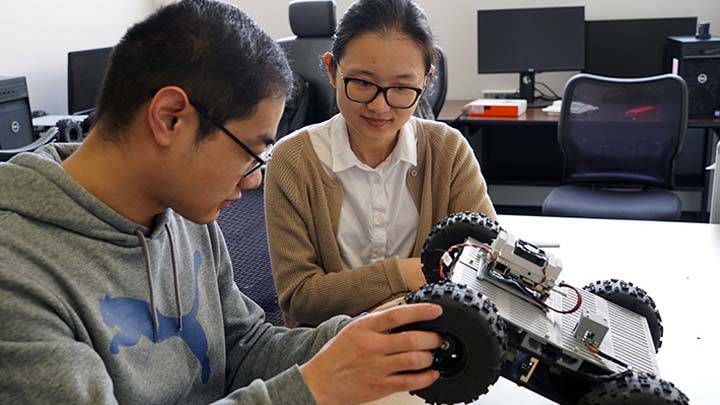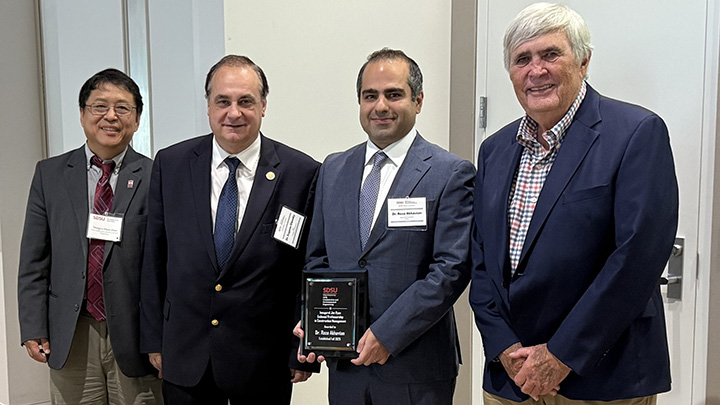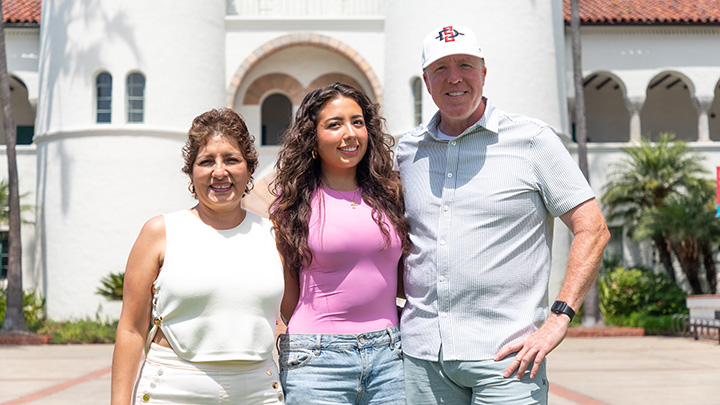$2.8 million NSF grant will expand AI education and research opportunities for students
In collaboration with the NSF Institute for Learning-enabled Optimization at Scale, the project will focus on diversity within the AI research community

The U.S. National Science Foundation (NSF)’s ExpandAI program last week awarded San Diego State University a $2.8 million, four-year grant to enhance the existing artificial intelligence infrastructure, education and research capacity and prepare students for careers in AI.
The project, “PARTNER: Expanding AI Capacity in San Diego: A Strategic Collaboration between San Diego State University and TILOS AI Institute,” will serve SDSU students as well as K-12 and community college students from diverse backgrounds.
“This project will provide cutting-edge AI research and education to the diverse community of innovators and future leaders in the San Diego region,” said Junfei Xie, electrical and computer engineer and principal investigator (PI).
SDSU is partnering with the University of California San Diego and the NSF Institute for Learning-enabled Optimization at Scale (TILOS) on the project, which focuses on optimizing the safety and reliability of autonomous AI systems for robotics and networks. Think drones, smart power networks, self-driving cars and even space vehicles.
“They have to operate without human intervention, without me telling them, no, stop, that's a pedestrian,” said co-PI and computer scientist Bryan Donyanavard. “In order to do that successfully, they need to be able to handle the uncertainties that come along with the real world: snowy days, extreme darkness and those types of factors. The more uncertainty that my pizza delivery drone can handle, the more that you trust it to deliver your pizza without crashing into a building.”
Diversifying the AI workforce
A major objective of the project is to diversify the AI workforce so as to better reflect the population of Southern California, including underrepresented minorities. To do this, it will develop AI learning opportunities for San Diego-area middle schools, high schools and community colleges.
“With its diverse population, SDSU is an ideal place for cultivating talent from diverse backgrounds for a diverse AI workforce,” said Xie.
The project will enhance the AI components of an existing robotics summer camp at SDSU for middle and high school students, primarily underrepresented minorities and low-income students. According to Xie — who runs the camp every year — campers will create robot learning algorithms and test them in the real world. They’ll also learn from visiting AI experts and explore careers.
High school students will attend UCSD’s Data Science Discovery Bootcamp to learn how to code in Python, analyze and interpret data and run AI simulations they have created.
“Through activities like robotics camps and data science bootcamps, this program will attract more students, particularly underrepresented minorities, to join SDSU and pursue degree programs in engineering and science fields,” said Eugene Olevsky, dean of the College of Engineering.
One-third of SDSU undergraduates transfer from community colleges, and Donyanavard says some of these students may need to be brought up to speed on AI basics and on research methods. To ease the transition, the project will provide mentorship, AI research opportunities and career guidance to local community college students through SDSU’s STEM Pathways program. This program aims to reduce barriers to entry in STEM fields, supporting students during their transition to SDSU.
“The beauty is then they show up already ahead of the game with the skill sets they need to participate in research, to excel in their coursework and become attractive candidates for industry and talent,” said Donyanavard.
Building capacity
SDSU’s AI landscape is growing. As the world adapts to AI, faculty members are incorporating it into everything from developing mental health robots to tracking snakes.
The ExpandAI award supports the development of new courses in the College of Engineering including an introduction to AI and a course in reinforcement learning, which trains software by “rewarding” it for making optimal decisions. To make AI training more accessible, these courses will be open to students from across the university. Course materials developed by SDSU will also be shared with the private, San Diego-based National University to strengthen its STEM curriculum.
“The new courses will be the foundation to prepare students to understand AI and autonomy for applications in engineering, like robotics and autonomous aerospace vehicles,” said aerospace engineer Jun Chen, a co-PI on the project.
The collaboration with TILOS will also offer opportunities for SDSU faculty to broaden their fundamental and theoretical AI skill set and strengthen their teaching.
Undergraduate research experiences are the cornerstone of the project. Students will gain research experience in the Xie, Chen and Donyanavard labs, where they’ll delve into AI computing and work on algorithms to optimize the safety of “self-driving” aerospace vehicles, ground-based vehicles, and robots. They may also work on AI projects in other fields such as mechanical engineering, geography and physics.
The project will also establish a summer internship giving students the opportunity to conduct research in the labs of TILOS partner institutions such as UCSD, MIT and other leading AI institutes. At UCSD, students will participate in AI robotics research in the labs of computer scientist Hao Su and electrical and computer engineer Nikolay Atanasov, who are co-PIs on the project. The internships will prioritize underrepresented minority students.
The project will join AI initiatives around campus, including the James Silberrad Brown Center for Artificial Intelligence, AI4Business Lab and the AI Club. In addition, Information Technology Services offers resources on the use of AI at SDSU, and the university has introduced new GenAI guidelines for the responsible and ethical adoption of GenAI across the university community.
This project is made possible through U.S. National Science Foundation grant #2402689


